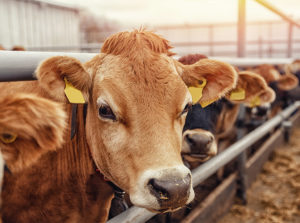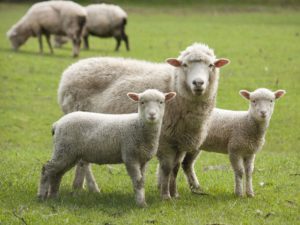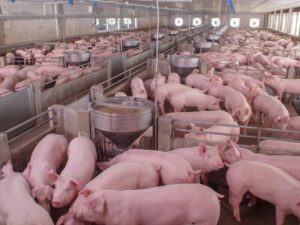Omega-3 Fatty Acids in Animal Nutrition
Omega-3 fatty acids namely alpha linolenic acid (ALA), eicosapentaenoic acid (EPA) and docosahexaenoic acid (DHA) are important components of cell membranes essential for health and normal physiological functioning of livestock and humans. None of these fatty acids are produced endogenously and therefore must be supplied in the diet. ALA originates from vegetables oil while EPA and DHA are abundant in marine fish oil and microalgae.
Although some EPA and EPA can be synthesised from ALA, it is important to clarify as misleading the concept that adequate intake of linolenic acid is sufficient to meet the requirements for the longer chain omega 3 fatty acids. The efficacy of conversion of linolenic acid to EPA is limited to less than 10% and further transformation to DHA is negligible. As such, marine supplements rich in the preformed poly long chain omega-3 fatty acids produce more beneficial effects than ALA alone.
In human nutrition, there is strong evidence to suggest that increased intake of the preformed omega 3 fatty acids in fish oil, especially DHA, improves physiological and health outcomes during pregnancy and lactation, depressed immune function, cardiovascular disease, cancer, and some mental and emotional conditions. For instance, intake of at least 200mg DHA daily is recommended for pregnant and breast-feeding mothers.
Similarly in livestock, supplementation of omega 3 fatty acids has been demonstrated to improve immune function, health status and reproductive efficiency. These beneficial effects have positive bearing on livestock performance and farm profitability.
Role of omega 3 FA in dairy cows

Dietary fat supplements are commonly used to increase the energy density of rations in lactating dairy cows to support increase in milk production, butter fat yield and body reserves. The majority of these supplements are often lacking in the omega 3 fatty acids despite the increasing recognition of the bioactive properties of the fatty acids and their role in health and reproduction in the dairy cow. Furthermore, the fatty acids when fed without some form of rumen protect or escape from microbial degradation do not reach the small intestine in adequate amounts for absorption, and eventual uptake in ruminant tissues and products.
EPA and DHA are the key fatty acids involved in fertility specifically in altering the production of prostaglandin in favour of progesterone. Prostaglandin is the hormone responsible for regression of corpus luteum which produces progesterone the hormone required for coordinating the supply of nutrients for embryo development and maintenance of pregnancy. Enhanced egg quality is also critical in embryo transfer programmes in animal breeding.
Studies in the US have confirmed that inclusion of EPA and DHA in the form of fish meal, fish oil, or microalgae in the diet has the potential to improve either first-service or overall pregnancy in six studies. Researchers at the University of Florida demonstrated that supplementation with calcium salts of fish oil starting at 30 days in milk enhanced pregnancy rate by more than 7% compared with calcium salts of palm fatty acid.
In other research, pregnancy loss in dairy cows between 32- and 60-days following service have been reduced by close to 6% through feeding calcium salts containing EPA and DHA. More recent report indicates that feeding 100 g/day of microalgae product containing 10% of dry matter as DHA from third week post calving increased pregnancy rate by 39% and reduced days to pregnancy by 22.
The omega 3 fatty acids are also associated with anti-inflammation, neonatal vigour and semen quality. The anti-inflammatory attribute has a sparing effect on energy from being used in fighting infection to channelling it to the mammary gland for milk production, and other productive purposes.
Role of omega 3 FA in calves

Calves are born immunologically immature and are highly susceptible to infectious diseases. Therefore, morbidity and mortality of dairy calves is a major challenge affecting calf performance, profitability and sustainability of dairy operations. Neonatal diarrhoea is one of the major causes of calf mortality on dairy farms. Feeding and management strategies to improve the growth and health of calves in the pre-weaning phase can increase dairy herd productivity.
Research has shown that the inclusion of omega 3 fatty acids in calf feed aids in the treatment of diarrhoea and other inflammatory conditions early in life. The omega 3 polyunsaturated fatty acids have many biological functions, including the regulation of immune function and improvement of the antioxidant capacity which can help in the treatment of diarrhoea and other infections soon after birth. There are reports that supplementing newly born Friesian calves with 20g/day microalgae increased average daily gain by 15% and inclusion of 6g/day of the same in a calf starter diet increased feed intake. The outcomes can be attributed to the possible effect of DHA in reducing oxidative stress, increasing the expression of muscle mediator of growth hormone and activating insulin receptors to promote muscle protein synthesis.
Role of omega 3 FA in sheep

As in other animals, omega 3 FA have important metabolic roles in immunity, neurological development and reproduction in sheep. They support the production of progesterone, the hormone responsible for the nourishment and maintenance of the embryo thus improving its viability. Application of fish oil in flushing diets improves multiple lambing, prolificacy and weaning rate.
Omega-3 fatty acids are considered as important modulators of immune functions. Soon after lambing the fatty acids enhance immunity of the ewe and aid in the regeneration of the reproductive tissues in readiness for rebreeding.
In late gestation the fatty acids play a vital role in the development of the brain and retina of the foetus to reduce the latency to suckle, and improve lamb survival rate. Research has shown that supplementation of ewe diet with fish oil up to 20g/day during late pregnancy improves lamb survival and output at weaning.
Omega-3 fatty acids in other species have been reported to enhance liver metabolism leading to increased fatty oxidation and plasma glucose concentrations thereby reducing the risk of ketosis immediately following birth. This effect can also help lessen incidences of Pregnancy Toxaemia in sheep.
Intake of omega-3 fatty acids enriches meat with these essential nutrients and improves fat distribution within the carcass to promote healthiness of lamb products to the consumer. Research has also established that fish oil in sheep diet can increase feed efficiency.
Role of omega 3 FA in pigs

Studies have identified a number of potential benefits of increasing DHA content of livestock diets on growth performance, meat production, egg production, fertility, progeny performance, immunity and bone parameters.
In growing pigs, supplementation with marine algae DHA has been shown to increase protein accretion resulting in numerical improvement in body weight gain and FCR as well as DHA levels in lion and subcutaneous fat. In one study, finishing pigs fed 1.6% marine algae containing 18% DHA just over three weeks prior to slaughter exhibited improved growth rate significantly. Other observations included improved indicators of neonatal piglet vigour, potentially improving the number of piglets reared per sow.
With regard to reproduction, researchers have observed increased, rapid return to oestrus, better embryo survival and larger litter size in older parity sows thereby enhancing longevity and lifelong performance. Others have reported reduced response to immune stress challenge in piglets, better feed intake and live weight gain. Elsewhere, high anti-inflammatory markers have been recorded in the colostrum and milk from sows fed fish oil leading to higher weaning weight and survival rate.
In breeding boars, long chain polyunsaturated omega-3 fatty acids in spermatozoa account for up to 65% of total fatty acids present with DHA highest in concentration. DHA forms an integral part of the cellular structure, improves the membrane integrity and fluidity of the spermatozoa, resulting in increased total motility, sperm progressive motility, and velocity parameters of the semen necessary fertilisation success.
Dietary supplementation with vitamin E anti-oxidant and selenium with co-factorial role in cellular metabolism and structural integrity improves the beneficial effects of additional DHA on semen characteristics including survivability in storage. The combination of DHA and antioxidant supplementation of boar diet means:
• Boars stud owner increasing semen volume ejaculate and concentration
• Boar stud customer getting more pigs born per services
Being the most consumed meat worldwide the enrichment of pork and co-products offers a largely untapped opportunity to help close the omega-3 fatty acid nutrition gap in human nutrition. To this end, determining and achieving optimal omega-3 enrichment of pig products through supplementation with fish oil and microalgae to meet human dietary needs offer a great opportunity of improving consumer health.
Role of omega 3 FA in poultry

The growth of poultry production has increased exponentially over the last several decades. This rapid expansion has and continues to be driven by growing consumer demand for animal protein. In order to meet the production demand modern poultry have undergone intensive genetic selection for higher reproductive performance, rapid growth rate, more egg production and overall superior feed efficiency.
The increased productivity in poultry is anchored on faster metabolic rate which has brought with it accelerated occurrence of metabolic disorders that compromise immunocompetence and resistance to pathological infections. While antibiotic growth promoters have been used to ameliorate lowered immune response, consumer pressures are forcing poultry industry to move away from overdependency on therapeutics. The concept of developing nutrition and management programmes to support immune system as a means of blunting metabolic disorders and diseases would be a welcome approach to minimise the usage of antibiotics.
Egg yolk is a vital reservoir for energy and essential fatty acids including omega 3s for the developing embryo. Research has reported a decline in late-stage embryonic mortality in fertile eggs from fish oil enriched diets. This could be due to the improved incubation parameters as a result of availability of the essential fatty acids. In effect, adequate supply of omega 3 fatty acids through dietary supplementation and deposition in the yolk is pivotal in the development of metabolic and immune functions with long-term implications on susceptibility to metabolic disorders in poultry.
The enrichment in eggs is proportional to the amount of the omega 3 fatty acids in the poultry diet and can be an extremely novel nutritional strategy of enhancing their supply in human food. By fortifying livestock feed with fish oil or algae the level of DHA can be increased by 20-fold in fish, 7-fold in chicken, and 3 to 6-fold in eggs.
Often genetic selection for feed efficiency discriminates against the other important parameters such as skeletal development exposing the progeny to leg weakness and lameness with the ultimate outcomes that may include culling, poor production and economic losses. Studies point to a positive correlation between increased growth rate and structural integrity of the skeleton to intake of omega 3 fatty acids.
Researchers at Bristol University reported 40 to 60% reduction in keel bone breakage rate and a corresponding drop in breakage severity in the omega-3 supplemented free range laying hens, compared with standard diets. The improved skeletal health could improve productivity of as many as 68 million hens that suffer keel fractures in the EU each year. An important finding that could also improve health and wellness of human patients suffering from osteoporosis.
Role of omega 3 FA in pets
Omega-3 fatty acids are essential for important metabolic functions in the body. They maintain the cell membrane fluidity and permeability needed for optimally functioning cells that provide numerous health benefits for both humans and their cats and dogs. The fatty acids are only available through diet or supplementation.
Humans and dogs have limited ability to convert ALA to EPA and DHA with cats having even lesser ability to do so. Supplementation with a high-quality omega-3 fish oil is therefore recommended for pets in order to maintain optimal health and wellbeing.
A key function of the omega-3 fatty acids is to support the body’s natural immune response. Cats and dogs are known to suffer from numerous inflammatory conditions associated with the skin, joints, kidneys and heart that can affect their health and welfare.
DHA plays a key role in brain and eye development. Research has demonstrated that feeding pregnant dogs omega-3 fatty acid-enriched foods during gestation and lactation provides the much-needed DHA to their offspring. Puppies that are weaned onto foods containing DHA have improved electroretinographic responses of the retina to light stimulation, and active response during training.
In addition, omega 3 supplementation is recognised to help maintain general skin condition and coat quality. In cats and dogs with inflammatory conditions, including allergies, one may notice improvements in clinical signs such as scratching, itching, and redness of the skin following supplementation with the fatty acids. Studies in humans have shown that omega-3 fatty acid supplementation supports weight loss something which might be of interest to pet owners as well.
The requirements for both EPA and DHA for pets have been established. Based on the scientific evidence indicating that long chain omega-3 fatty acids are needed for the development of the nervous and visual systems during foetal and neonatal life stages, The European Pet Food Industry Nutritional Guidelines recommends a dietary minimum concentration of EPA plus DHA at 0.05% on dry matter (DM) basis for growing and reproductive dogs. Similarly in cats, the recommended daily allowance is 0.01% per kg DM.
Role of omega 3 FA in horses
Supplementation of horse feed with omega 3 fatty acids can provide extra calories in a beneficial and highly useable form to the animal. The fatty acids play a vital role in cellular repair and formation of tissues, brain function, growth, development and coat conditioning.
Although the omega ALA is plenty in green grass which is the basal diet for horses during summer the level of the fatty acids in conserved forages declines significantly in winter as a result of lipid oxidation. Moreover, horse studies indicate that supplementation with ALA only increases the level of EPA and not DHA in the tissues.
The horse like other animal species cannot synthesise the omega 3 fatty acids in sufficient quantities to meet their nutritional needs and must be available in the diet on a daily basis. The fatty acids are therefor considered as essential in equine nutrition. The fatty acids are anti-inflammatory and can improve calcium deposit and bone strength. Omega-3 fatty acids have been proven to aid horses with stomach ulcers, arthritis, allergies, auto-immune diseases, hoof quality, reproduction, joint health, laminitis, respiratory issues, and many more including lowering the risk of colic and pulmonary bleeding.
Arthritis is the most important cause of lameness in horses and can lead to the early retirement of otherwise healthy animals. Inclusion of the omega 3 fatty acids in the diet may minimise the potential for inflammation of the joint at the cellular level, and lower pain. Research conducted in a variety of animal species has shown the fatty acids have the potential to lessen the pain and inflammation caused by arthritis, and assist in slowing joint degradation. All together, these inflammatory conditions can result in a loss of function and performance of the horse.
At Kansas State University they found that exercise-induced pulmonary haemorrhage was reduced in Thoroughbreds after they were supplemented with DHA for 83 days. Similar benefits of DHA were also reported by the University of Liege in Belgium when they observed an increase in the red blood cell membrane fluidity in exercise horses that were fed a diet enriched with EPA and DHA for four weeks.
In summary, the beneficial effects of omega 3 fatty acids include the following:
• Improved athletic performance by reducing inflammation
• Increased fluidity of the red blood cells and tolerance to exercise leading to improved respiratory health
• Boosted immune response and resistance to infections
• Enhanced semen characteristics in frozen and cooled semen
• Better hoof and skin coat conditions
• Help in recovery from cellulitis, gas colic, inflammatory bowel, colitis, and laminitis
Conclusion
Studies have demonstrated that omega 3 fatty acids are important components of cell membranes with pivotal role in cellular metabolism that benefit animals and humans in diverse ways including organ development, health, reproduction and overall wellbeing. The fatty acids are classified as essential since they cannot be synthesised by the body, and therefore must be obtained through dietary supplementation.
Linolenic acid can be converted into the longer chain omega 3 fatty acids but the process is insufficient to meet the requirements of the prolific genetics of the present-day animal with high metabolic rate. In order to enhance the status of EPA and DHA in animals, dietary supplements containing fish oil or marine algae are highly recommended.
Nutritional manipulation provides a novel strategy of enriching livestock products such as milk, meat, pork and eggs for the benefit of human nutrition and wellness. However, the challenge of doing this is unique in ruminants where the fatty acids are altered through microbial biohydrogenation.
UFAC have developed, over the years, innovative process of producing a variety of omega 3 supplements. They are rumen-inert and slow release designed to improve absorption of the omega 3 fatty acids by the animal and uptake in the tissues. This noble technology provides an opportunity for niche markets for products containing greater amounts of the omega 3 fatty acids without involving chemical treatment or coating processes that could be costly and risk product integrity.


 Back to Resources
Back to Resources 